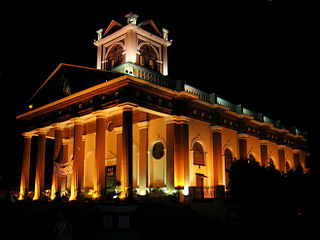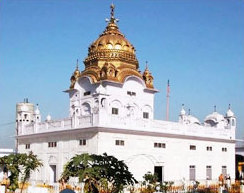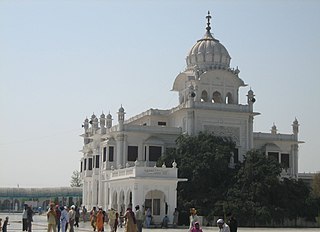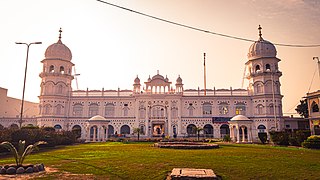
A gurdwara or gurudwara is a place of assembly and worship for Sikhs but its normal meaning is place of guru or "Home of guru". Sikhs also refer to gurdwaras as Gurdwara Sahib. People from all faiths and religions are welcomed in gurdwaras. Each gurdwara has a Darbar Sahib where the Guru Granth Sahib is placed on a takht in a prominent central position. Any congregant may recite, sing, and explain the verses from the Guru Granth Sahib, in the presence of the rest of the congregation.

Kapurthala is a city in Punjab state of India. It is the administrative headquarters of Kapurthala District. It was the capital of the Kapurthala State, a princely state in British India. The aesthetic mix of the city with its prominent buildings based on French and Indo-Saracenic architecture self-narrate its princely past. It is also known as city of Palaces & Gardens. According to the 2011 census, Kapurthala is the least populated city in India.

Gurdwara Panja Sahib is a famous gurdwara located in Hasan Abdal, Pakistan. The shrine is considered to be particularly important as the handprint of the founder of Sikhism, Guru Nanak, is believed to be imprinted on a boulder at the gurdwara.

Dera Baba Nanak is a town and a municipal council in Gurdaspur district, in the state of Punjab, India. It is the sub-district headquarters of Dera Baba Nanak tehsil. It is 36 km away from Gurdaspur city, the capital of the district. Since November 2019, a corridor between India and Pakistan has been established at its shrine.
The town of Mullanpur Dakha,' also known as Mandi Mullanpur, is located in the Ludhiana district in the Indian state of Punjab. It is a nagar panchayat, a settlement in transition from rural to urban. Due to the availability of transport routes to other villages, the town serves as a marketplace of grain and other goods to the surrounding area.

Sultanpur Lodhi is a city and a Municipal Council, just 17 miles Kapurthala city in the Kapurthala district in the Indian state of Punjab. The town is named after its founder, Bahlol Lodhi, the future Sultan of Delhi who renamed the town in 1443 C.E. during his time as governor of Punjab, and has also been mentioned in the Ain-e-Akbari. Sultanpur Lodhi is located on the south bank of a seasonal rivulet called Kali Bein, which runs 6 miles (9.7 km) north of the confluence of the Beas and Sutlej rivers of Punjab.

Gurdwara Nanak Shahi is the principal Sikh Gurdwara in Dhaka, Bangladesh. It is located at the campus of the University of Dhaka and considered to be the biggest of the 9 to 10 Gurdwaras in the country. The Gurudwara commemorates the visit of Guru Nanak (1506–1507). It is said to have been built in 1830. The present building of the Gurdwara was renovated in 1988–1989. The parkarma verandah had been constructed on all four sides of the original building to provide protection.

German Sikhs are a growing religious minority in Germany. The majority of German Sikhs have their roots from the Punjab, India with the remaining coming from the Afghan Sikh community or through conversion. The number of Sikhs is estimated to be between 25,000. Germany had the fifth highest Sikh population in Europe after United Kingdom (524,000), Italy (220,000), Portugal (35,000) and Spain (26,000).
Gurdawara Bair Sahib also called Baba Beri or Baba Bair is situated in Sialkot, Pakistan. It was the place where Baba Guru Nanak stayed and met Hamza Ghaus, a famous saint of Sialkot. The berry tree under which Guru Nanak stayed is still present. The gurdwara was built by Natha Singh and it includes a garden, a pool and residential rooms. The gurdwara was damaged in the wake of the Babari Masjid dispute. There used to be a very high temple which was razed to ground when it was demolished by an unruly mob.
Gurdwara Pahila Bara, commonly known as Gurdwara Gai Ghat, is a holy Gurdwara of Sikh religion. It is located in the city of Patna, Bihar, India and dedicated to Guru Nanak Dev. The Gurdwara is part of "Guru Circuit" - A Government of Bihar initiative connecting important Sikh religious destinations in Bihar to attract more pilgrims.

Gurdwara Darbar Sahib Kartarpur, also called Kartarpur Sahib, is a gurdwara in Kartarpur, located in Shakargarh, Narowal District, in the Punjab province of Pakistan. It is built on the historic site where the founder of Sikhism, Guru Nanak, settled and assembled the Sikh community after his missionary travels and lived for 18 years until his death in 1539. It is one of the holiest sites in Sikhism, alongside the Golden Temple in Amritsar and Gurdwara Janam Asthan in Nankana Sahib.

Gurū Nānak, also known as Bābā Nānak, was the founder of Sikhism and is the first of the ten Sikh Gurus. His birth is celebrated as Guru Nanak Gurpurab on Katak Pooranmashi, i.e. October–November.

Gurdwara Janam Asthan, also referred to as Gurdwara Nankana Sahib, is a highly revered gurdwara that is situated at the site where the founder of Sikhism, Guru Nanak, was born. The shrine is located in Nankana Sahib, Punjab, Pakistan.

Hazur Sahib, also known as Takht Sachkhand Sri Hazur Abchalnagar Sahib, is one of the five takhts in Sikhism. The gurdwara was built between 1832 and 1837 by Maharaja Ranjit Singh (1780–1839). It is located on the banks of the Godavari River at the city of Nanded in the state of Maharashtra, India.
Gurdwara Nagiana Sahib is a Gurudwara, or holy Sikh shrine, located in Udoke, a small village near Batala in Punjab, India. The shrine was built by the Sikh saint Sant Baba Chuggat Singh Ji, who served as the first official Sewadar (volunteer) of the shrine.

Nanakmatta is a historical town named after the Sikh pilgrimage site, Gurdwara Nanak Mata Sahib, in the state of Uttarakhand, India. Sikh tradition records that the site was once called Gorakhmata, a centre of Siddh-jogis named after the founder of their order, Gorakhnath, at the distance of 30 miles from Reetha sahib. In the Siddh-Gost in Guru Granth Sahib, the story of Guru Nanak ji on his first udasi is told, wherein he had a long discourse with siddhas on matters of religion and metaphysics. Tradition says that the place was renamed Nanakmatta to perpetuate the memory of Guru's visit. The town is associated with Guru Nanak Dev and Guru Hargobind.

Guru Nanak Jhira Sahib is a Sikh historical shrine situated in Bidar, Karnataka. Gurdwara Nanak Jhira Sahib was built in 1948 and is dedicated to the first Sikh guru, Guru Nanak. Bidar has a very long association with Sikhism as this is the home town of Bhai Sahib Singh, one of the Panj Pyare, who offered to sacrifice their heads and were later baptised as the first members of the Khalsa.
Gurudwara Reetha Sahib is situated in Champawat district, Uttarakhand, India. It is 16 hours journey away from Chandigarh approx. This gurudwara holds a very sacred place in Sikh Religion as Guru Nanak Dev himself had visited this place with Bhai Mardana.














